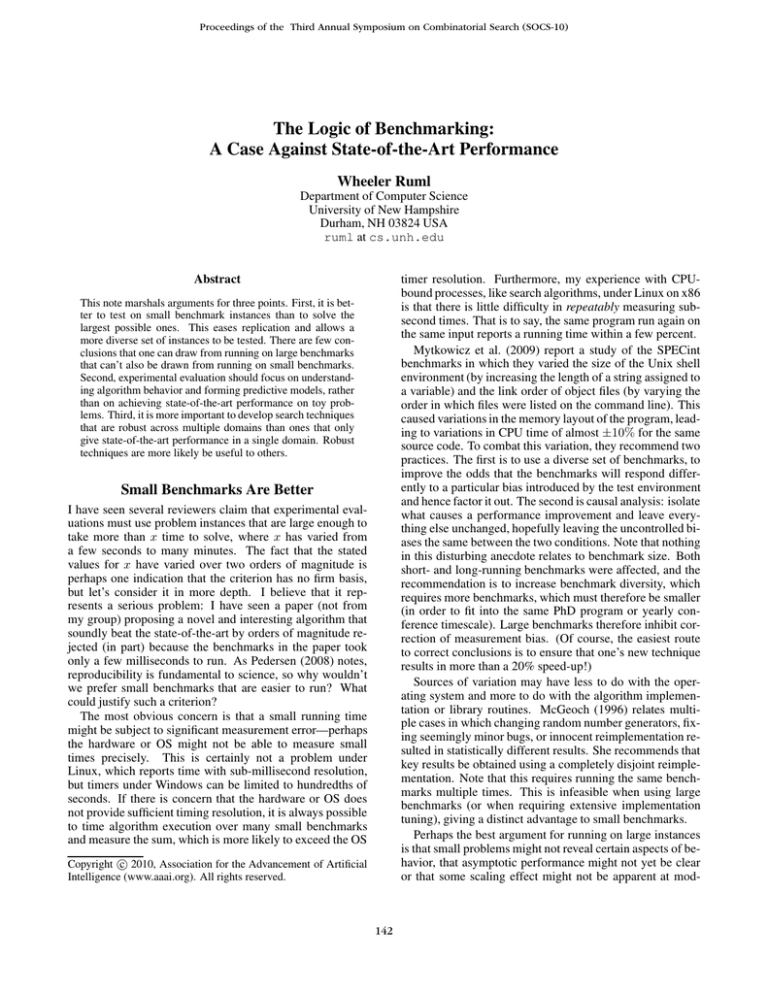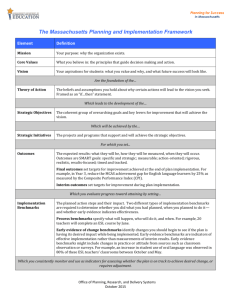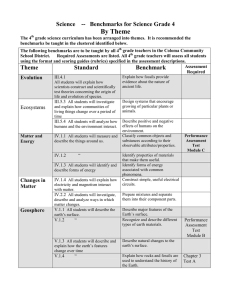
Proceedings of the Third Annual Symposium on Combinatorial Search (SOCS-10)
The Logic of Benchmarking:
A Case Against State-of-the-Art Performance
Wheeler Ruml
Department of Computer Science
University of New Hampshire
Durham, NH 03824 USA
ruml at cs.unh.edu
Abstract
timer resolution. Furthermore, my experience with CPUbound processes, like search algorithms, under Linux on x86
is that there is little difficulty in repeatably measuring subsecond times. That is to say, the same program run again on
the same input reports a running time within a few percent.
Mytkowicz et al. (2009) report a study of the SPECint
benchmarks in which they varied the size of the Unix shell
environment (by increasing the length of a string assigned to
a variable) and the link order of object files (by varying the
order in which files were listed on the command line). This
caused variations in the memory layout of the program, leading to variations in CPU time of almost ±10% for the same
source code. To combat this variation, they recommend two
practices. The first is to use a diverse set of benchmarks, to
improve the odds that the benchmarks will respond differently to a particular bias introduced by the test environment
and hence factor it out. The second is causal analysis: isolate
what causes a performance improvement and leave everything else unchanged, hopefully leaving the uncontrolled biases the same between the two conditions. Note that nothing
in this disturbing anecdote relates to benchmark size. Both
short- and long-running benchmarks were affected, and the
recommendation is to increase benchmark diversity, which
requires more benchmarks, which must therefore be smaller
(in order to fit into the same PhD program or yearly conference timescale). Large benchmarks therefore inhibit correction of measurement bias. (Of course, the easiest route
to correct conclusions is to ensure that one’s new technique
results in more than a 20% speed-up!)
Sources of variation may have less to do with the operating system and more to do with the algorithm implementation or library routines. McGeoch (1996) relates multiple cases in which changing random number generators, fixing seemingly minor bugs, or innocent reimplementation resulted in statistically different results. She recommends that
key results be obtained using a completely disjoint reimplementation. Note that this requires running the same benchmarks multiple times. This is infeasible when using large
benchmarks (or when requiring extensive implementation
tuning), giving a distinct advantage to small benchmarks.
Perhaps the best argument for running on large instances
is that small problems might not reveal certain aspects of behavior, that asymptotic performance might not yet be clear
or that some scaling effect might not be apparent at mod-
This note marshals arguments for three points. First, it is better to test on small benchmark instances than to solve the
largest possible ones. This eases replication and allows a
more diverse set of instances to be tested. There are few conclusions that one can draw from running on large benchmarks
that can’t also be drawn from running on small benchmarks.
Second, experimental evaluation should focus on understanding algorithm behavior and forming predictive models, rather
than on achieving state-of-the-art performance on toy problems. Third, it is more important to develop search techniques
that are robust across multiple domains than ones that only
give state-of-the-art performance in a single domain. Robust
techniques are more likely be useful to others.
Small Benchmarks Are Better
I have seen several reviewers claim that experimental evaluations must use problem instances that are large enough to
take more than x time to solve, where x has varied from
a few seconds to many minutes. The fact that the stated
values for x have varied over two orders of magnitude is
perhaps one indication that the criterion has no firm basis,
but let’s consider it in more depth. I believe that it represents a serious problem: I have seen a paper (not from
my group) proposing a novel and interesting algorithm that
soundly beat the state-of-the-art by orders of magnitude rejected (in part) because the benchmarks in the paper took
only a few milliseconds to run. As Pedersen (2008) notes,
reproducibility is fundamental to science, so why wouldn’t
we prefer small benchmarks that are easier to run? What
could justify such a criterion?
The most obvious concern is that a small running time
might be subject to significant measurement error—perhaps
the hardware or OS might not be able to measure small
times precisely. This is certainly not a problem under
Linux, which reports time with sub-millisecond resolution,
but timers under Windows can be limited to hundredths of
seconds. If there is concern that the hardware or OS does
not provide sufficient timing resolution, it is always possible
to time algorithm execution over many small benchmarks
and measure the sum, which is more likely to exceed the OS
c 2010, Association for the Advancement of Artificial
Copyright Intelligence (www.aaai.org). All rights reserved.
142
General-purpose Techniques are Better
est problem sizes. Eppinger (1983) presents a case in which
both theoretical analysis and initial empirical results agreed
that a certain behavior would occur, but runs on much larger
instances revealed evidence of the entirely opposite behavior
(eventually resulting in a more refined theoretical analysis).
(McGeoch (1996) cites two additional examples.) However,
running on large instances can never preclude the possibility
that running on even larger instances would uncover contradictory evidence. One can be no more logically certain
when extrapolating from large benchmarks than from small
ones. Both exercises must be treated as speculative, leaving large and small benchmarks equivalent in this respect.
Overall, there seem to be few firm conclusions that one can
draw from running on large benchmarks that couldn’t also
be drawn from running on small benchmarks. Given that
smaller benchmarks allow a wider variety of problems and
algorithm variations to be tested and a greater understanding
of behavior to be developed, the choice is clear.
One final motivation for larger benchmarks is the concern
that small problems might not be realistic or relevant, presumably with respect to commercial applications. The assumption seems to be that ‘real-world’ necessarily equals
‘large’. I have personal experience with two industrial applications. In one case each problem instance had to be solved
within 270 milliseconds and in the other each instance had to
be solved within one minute. The two most celebrated recent
uses of heuristic search, in game pathfinding (Nathan Sturtevant’s work on Dragon Age: Origins) and in robotic motion
planning (Max Likhachev’s and David Ferguson’s work on
the DARPA Urban Challenge), also both require fast solving
(in milliseconds and seconds, respectively). Such problems
may have intricate complexities, but the instantiated portion
of the search space certainly cannot be called large.
If we take as the goal of academic research on heuristic
search to supply industry with a toolkit of well-understood
algorithms and techniques, then perhaps the most valuable
contribution would be methods that perform reliably across
many different domains, rather than extremely well on some
and extremely poorly on others. Achieving state-of-the-art
performance on problem X through tricks that only apply to
X is only interesting to those who face problem X. If X is
a toy problem, that will be very few people. If the community concerned itself only with that style of work, it would
risk, in the words of one journal reviewer “the impression
that heuristic search has become a community that is only
interested in peculiarities of the 15-puzzle, talks only to itself, and has no relevance to broader AI or CS research.” A
very generic method that will perform reasonably well on
any problem that looks vaguely like X or Y or Z will find a
much broader audience.
To test such a method, it is not necessary to implement
the very latest state-of-the-art heuristic function for a single
toy benchmark domain. It is critical that the method is tested
in a wide variety of search spaces, but performance on any
single particular problem is beside the point. Methods with
special requirements, such as integer costs, real costs with
a large lowest common denominator, or undirected graph
edges would rate low in this endeavor.
Such a ‘method of first resort’ could become the Sawzall
of search. My personal view is that the popularity of genetic
algorithms and local search comes in large part from the
broad applicability of those methods, rather than from superior performance. What of comparable value can heuristic
search offer? We will have succeeded when we see multiple
industrial sponsors at SoCS, eager for our ideas.
Acknowledgments
Benchmarking is for Understanding
I am grateful for helpful comments from Jordan Thayer, Nathan
Sturtevant and Ariel Felner and for support from the U.S.
NSF (grant IIS-0812141) and the DARPA CSSG program (grant
HR0011-09-1-0021).
As Hooker (1994, 1995) eloquently laments, it is easy to be
drawn into treating benchmarks as a competition rather than
as science (advancing understanding). I have seen a SoCS
reviewer state “I believe that any publishable paper should
demonstrate at least one domain on which the authors’ algorithm outperforms the previous state of the art.” But it is
important to keep in mind that very few people really care
about solving our toy puzzles. Real applications tend to be
messy and complex, exactly the opposite of the simplicity
we desire in a benchmark. Benchmarks are for helping us
understand how algorithms behave. As Knuth (1996) argues, toy problems are important because they help us hone
general techniques that will be broadly useful. Surpassing
the current state-of-the-art in performance in a toy domain
is certainly one indication that an idea has merit, but it is
understanding rather than bragging rights that should be the
ultimate goal of a paper. We seek algorithms or algorithmic
techniques that are well-enough understood that we are comfortable recommending them to our colleagues in industry
who are facing the real problems. Developing this predictive understanding is implicitly discouraged by emphasizing
state-of-the-art performance.
References
Eppinger, J. L. 1983. An empirical study of insertion and deletion
in binary search trees. Comm. of the ACM 26(9):663–669.
Hooker, J. N. 1994. Needed: An empirical science of algorithms.
Operations Research 42(2):201–212.
Hooker, J. N. 1995. Testing heuristics: We have it all wrong.
Journal of Heuristics 1:33–42.
Knuth, D. E. 1996. Are toy problems useful? In Selected Papers on Computer Science. CSLI. chapter 10, 169–183. Originally
published in Popular Computing, 1977.
McGeoch, C. C. 1996. Toward an experimental method for algorithm simulation. INFORMS Journal on Computing 8(1):1–15.
Mytkowicz, T.; Diwan, A.; Hauswirth, M.; and Sweeney, P. F.
2009. Producing wrong data without doing anything obviously
wrong! In Proceedings of ASPLOS, 265–276. ACM.
Pedersen, T. 2008. Empiricism is not a matter of faith. Computational Linguistics 34(3):465–470.
143




